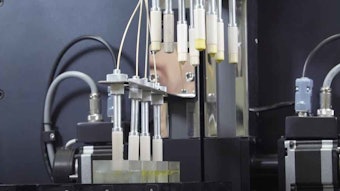Ultrastretchable Fibers with Metallic Conductivity
S Zhu et al.; North Carolina State University; Dec. 13, 2012 (online); Advanced Functional Materials
This paper describes ultra-stretchable fibers consisting of the liquid metal alloy eutectic gallium-indium injected into hollow fibers composed of a tri-block copolymer resin. These fibers are similar to conventional metallic wires in that they have a metal core surrounded by polymeric insulation; however, they differ in that they can be stretched orders of magnitudes further while retaining electrical conductivity. According to the authors, this liquid core has a negligible impact on the properties of the fibers. To demonstrate their utility, the researchers used the fibers as wires for stretchable earphones and a stretchable battery charger.
Developed as a textile, this technology could potentially be paired with an anti-aging treatment to mechanically improve skin elasticity, enhance delivery via electricity, or even induce hormesis for skin repair. Coated textiles have previously been designed as dressings to heal diabetic wounds, and as pantyhose to deliver anticellulite benefits. “I don’t know a whole lot about skin treatments,” co-author Dickey wrote to Cosmetics & Toiletries, “but you are correct that this technology is very appealing for electronic textiles because the wires can be integrated into fabrics/textiles without changing the mechanical properties.”
Mimicking Butterfly Wings
J Li, G Liang, X Zhu and S Yang; University of Pennsylvania; April 16, 2012 (online); Advanced Functional Materials
These authors were inspired by butterfly wings, whose colors are unusually bright due to the way they reflect light. Researchers created this “structural color” by fabricating three-dimensional diamond photonic crystals with nanoroughness on their surface generated by microphase separation during the rinsing step of holographic lithography. The degree of roughness can be tuned by cross-linking, and according to the authors, this periodic microstructure and nanoroughness also affords benefits such as superhydrophobicity and enhanced dye adsorption.
The most obvious applications for this technology are the creation of novel colors or visual effects in color cosmetics. In addition, water-repellency could find use in mascaras or sunscreens. “I believe [this] invention can be applied to personal care and cosmetics, where shiny colors are commonly used for shimmering [effects],” Shu Yang wrote to Cosmetics & Toiletries. She added, “Water repellency [also] can be applied in hair protection, making the hair smooth and non-sticky, and preserving color; and for protecting personal care products and their packaging.” However, she noted these applications are merely speculative.
Microdevices and Transdermal Delivery
M Ochoa, C Mousoulis and B Ziaie; Purdue University; November 2012; Advanced Drug Delivery Reviews
These researchers describe the manufacture of polymeric microdevices for the transdermal and subcutaneous delivery of actives. Devices range from microneedle arrays to systems including micropumps, microreservoirs, onboard sensors and intelligent electronics. According to the authors, this work could have a major impact on next-generation devices for the administration of biopharmaceuticals and other emerging formulations.
To some, this approach may take topical cosmetic delivery to a more invasive level; although it has been argued that microneedles penetrate no deeper than the stratum corneum, which maintains a “cosmetic” status. In either case, delivery is the key to efficacy for actives, and microdevices could be one way to get them to the right place at the right time.
Nanoelectronic Scaffolds for Delivery, Regeneration
B Tian et al.; Massachusetts Institute of Technology, Boston Children’s Hospital and Harvard University; Aug. 26, 2012; Nature Materials
In this work, the tiny sponge-like scaffolds used to control the shape of engineered tissues are not new; they previously have been implanted into patients or used in the lab to study tissue responses to drugs. However, here they were taken to a new level by incorporating electronic sensors, which potentially could monitor electrical activity in the tissue surrounding the scaffold, control drug release, or even screen drug candidates. Such porous, flexible and free-standing nanowire nanoelectronic scaffolds and their hybrids are important to fields ranging from cellular biophysics to regenerative medicine.
As noted, the potential of these scaffolds for controlled release may be an interesting proposal for cosmetic actives to improve product bioavailability and duration.
Measuring Oxidation
TP Dick et al.; German Cancer Research Center; Dec. 21, 2012; Nature Chemical Biology
Scientists have discovered a flaw in the current approach to determining oxidative stress in cells. The conventional method involves analyzing the presence and amount of oxidized glutathione. However, cells under stress have been found to deposit oxidized glutathione in a cellular waste repository, calling to question the validity of this indicator.
Biosensors were designed to indicate the oxidation state of glutathione in intact cells by releasing light signals. The path of oxidized glutathione through living yeast cells was then followed in real time. Surprisingly, the glutathione was promptly stored in vacuoles, thus protecting the cell cytoplasm from oxidative damage. So while previously the cells would have appeared to be under oxidative stress, they now appeared healthy. This was found to be true for yeast cells and various other mammalian cells, including cancer cells.
For personal care, this could mean re-thinking how to measure the effects of ingredients on oxidative stress for anti-aging or skin care applications. It could also mean a new approach to “beefing up” the skin’s own antioxidant defenses.










